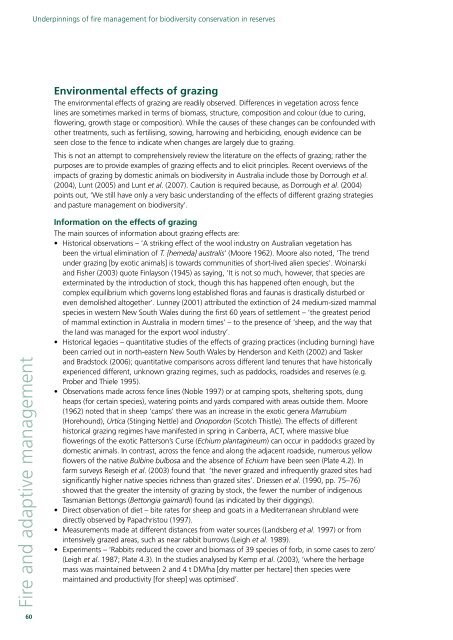Underpinnings of fire management for biodiversity conservation in ...
Underpinnings of fire management for biodiversity conservation in ...
Underpinnings of fire management for biodiversity conservation in ...
You also want an ePaper? Increase the reach of your titles
YUMPU automatically turns print PDFs into web optimized ePapers that Google loves.
60<br />
Environmental effects <strong>of</strong> graz<strong>in</strong>g<br />
The environmental effects <strong>of</strong> graz<strong>in</strong>g are readily observed. Differences <strong>in</strong> vegetation across fence<br />
l<strong>in</strong>es are sometimes marked <strong>in</strong> terms <strong>of</strong> biomass, structure, composition and colour (due to cur<strong>in</strong>g,<br />
flower<strong>in</strong>g, growth stage or composition). While the causes <strong>of</strong> these changes can be confounded with<br />
other treatments, such as fertilis<strong>in</strong>g, sow<strong>in</strong>g, harrow<strong>in</strong>g and herbicid<strong>in</strong>g, enough evidence can be<br />
seen close to the fence to <strong>in</strong>dicate when changes are largely due to graz<strong>in</strong>g.<br />
This is not an attempt to comprehensively review the literature on the effects <strong>of</strong> graz<strong>in</strong>g; rather the<br />
purposes are to provide examples <strong>of</strong> graz<strong>in</strong>g effects and to elicit pr<strong>in</strong>ciples. Recent overviews <strong>of</strong> the<br />
impacts <strong>of</strong> graz<strong>in</strong>g by domestic animals on <strong>biodiversity</strong> <strong>in</strong> Australia <strong>in</strong>clude those by Dorrough et al.<br />
(2004), Lunt (2005) and Lunt et al. (2007). Caution is required because, as Dorrough et al. (2004)<br />
po<strong>in</strong>ts out, ‘We still have only a very basic understand<strong>in</strong>g <strong>of</strong> the effects <strong>of</strong> different graz<strong>in</strong>g strategies<br />
and pasture <strong>management</strong> on <strong>biodiversity</strong>’.<br />
In<strong>for</strong>mation on the effects <strong>of</strong> graz<strong>in</strong>g<br />
The ma<strong>in</strong> sources <strong>of</strong> <strong>in</strong><strong>for</strong>mation about graz<strong>in</strong>g effects are:<br />
• Historical observations – ‘A strik<strong>in</strong>g effect <strong>of</strong> the wool <strong>in</strong>dustry on Australian vegetation has<br />
been the virtual elim<strong>in</strong>ation <strong>of</strong> T. [hemeda] australis’ (Moore 1962). Moore also noted, ‘The trend<br />
under graz<strong>in</strong>g [by exotic animals] is towards communities <strong>of</strong> short-lived alien species’. Wo<strong>in</strong>arski<br />
and Fisher (2003) quote F<strong>in</strong>layson (1945) as say<strong>in</strong>g, ‘It is not so much, however, that species are<br />
exterm<strong>in</strong>ated by the <strong>in</strong>troduction <strong>of</strong> stock, though this has happened <strong>of</strong>ten enough, but the<br />
complex equilibrium which governs long established floras and faunas is drastically disturbed or<br />
even demolished altogether’. Lunney (2001) attributed the ext<strong>in</strong>ction <strong>of</strong> 24 medium-sized mammal<br />
species <strong>in</strong> western New South Wales dur<strong>in</strong>g the first 60 years <strong>of</strong> settlement – ‘the greatest period<br />
<strong>of</strong> mammal ext<strong>in</strong>ction <strong>in</strong> Australia <strong>in</strong> modern times’ – to the presence <strong>of</strong> ‘sheep, and the way that<br />
the land was managed <strong>for</strong> the export wool <strong>in</strong>dustry’.<br />
• Historical legacies – quantitative studies <strong>of</strong> the effects <strong>of</strong> graz<strong>in</strong>g practices (<strong>in</strong>clud<strong>in</strong>g burn<strong>in</strong>g) have<br />
been carried out <strong>in</strong> north-eastern New South Wales by Henderson and Keith (2002) and Tasker<br />
and Bradstock (2006); quantitative comparisons across different land tenures that have historically<br />
experienced different, unknown graz<strong>in</strong>g regimes, such as paddocks, roadsides and reserves (e.g.<br />
Prober and Thiele 1995).<br />
• Observations made across fence l<strong>in</strong>es (Noble 1997) or at camp<strong>in</strong>g spots, shelter<strong>in</strong>g spots, dung<br />
heaps (<strong>for</strong> certa<strong>in</strong> species), water<strong>in</strong>g po<strong>in</strong>ts and yards compared with areas outside them. Moore<br />
(1962) noted that <strong>in</strong> sheep ‘camps’ there was an <strong>in</strong>crease <strong>in</strong> the exotic genera Marrubium<br />
(Horehound), Urtica (St<strong>in</strong>g<strong>in</strong>g Nettle) and Onopordon (Scotch Thistle). The effects <strong>of</strong> different<br />
historical graz<strong>in</strong>g regimes have manifested <strong>in</strong> spr<strong>in</strong>g <strong>in</strong> Canberra, ACT, where massive blue<br />
flower<strong>in</strong>gs <strong>of</strong> the exotic Patterson’s Curse (Echium plantag<strong>in</strong>eum) can occur <strong>in</strong> paddocks grazed by<br />
domestic animals. In contrast, across the fence and along the adjacent roadside, numerous yellow<br />
flowers <strong>of</strong> the native Bulb<strong>in</strong>e bulbosa and the absence <strong>of</strong> Echium have been seen (Plate 4.2). In<br />
farm surveys Reseigh et al. (2003) found that ‘the never grazed and <strong>in</strong>frequently grazed sites had<br />
significantly higher native species richness than grazed sites’. Driessen et al. (1990, pp. 75–76)<br />
showed that the greater the <strong>in</strong>tensity <strong>of</strong> graz<strong>in</strong>g by stock, the fewer the number <strong>of</strong> <strong>in</strong>digenous<br />
Tasmanian Bettongs (Bettongia gaimardi) found (as <strong>in</strong>dicated by their digg<strong>in</strong>gs).<br />
• Direct observation <strong>of</strong> diet – bite rates <strong>for</strong> sheep and goats <strong>in</strong> a Mediterranean shrubland were<br />
directly observed by Papachristou (1997).<br />
• Measurements made at different distances from water sources (Landsberg et al. 1997) or from<br />
<strong>in</strong>tensively grazed areas, such as near rabbit burrows (Leigh et al. 1989).<br />
• Experiments – ‘Rabbits reduced the cover and biomass <strong>of</strong> 39 species <strong>of</strong> <strong>for</strong>b, <strong>in</strong> some cases to zero’<br />
(Leigh et al. 1987; Plate 4.3). In the studies analysed by Kemp et al. (2003), ‘where the herbage<br />
mass was ma<strong>in</strong>ta<strong>in</strong>ed between 2 and 4 t DM/ha [dry matter per hectare] then species were<br />
ma<strong>in</strong>ta<strong>in</strong>ed and productivity [<strong>for</strong> sheep] was optimised’.<br />
Fire and adaptive <strong>management</strong> <strong>Underp<strong>in</strong>n<strong>in</strong>gs</strong> <strong>of</strong> <strong>fire</strong> <strong>management</strong> <strong>for</strong> <strong>biodiversity</strong> <strong>conservation</strong> <strong>in</strong> reserves





![Metcalfe State Forest Fauna Species List [PDF File - 16.9 KB]](https://img.yumpu.com/22024301/1/184x260/metcalfe-state-forest-fauna-species-list-pdf-file-169-kb.jpg?quality=85)






![PPE Price List for Wildlife Volunteers [PDF File - 20.3 KB]](https://img.yumpu.com/15321634/1/190x135/ppe-price-list-for-wildlife-volunteers-pdf-file-203-kb.jpg?quality=85)




